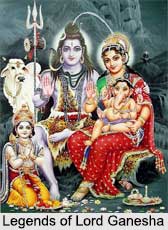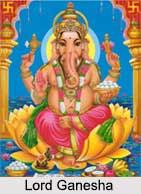 Legends of Lord Ganesha include several stories that are mentioned in the Mahapuranas, Upapuranas and other Hindu religious texts. He is the Remover of Obstacles and is the most renowned Hindu Gods in India. The various Puranas, such as Shiva Purana, Ganesha Purana, Brahmavaivarta Purana and Mudgala Purana, provide various legends and tales related to his birth, childhood and marriage. It also depicts the nature and character of Lord Ganesha. He is described as the God of literature, wisdom and success and the destroyer of pride, selfishness and vanity.
Legends of Lord Ganesha include several stories that are mentioned in the Mahapuranas, Upapuranas and other Hindu religious texts. He is the Remover of Obstacles and is the most renowned Hindu Gods in India. The various Puranas, such as Shiva Purana, Ganesha Purana, Brahmavaivarta Purana and Mudgala Purana, provide various legends and tales related to his birth, childhood and marriage. It also depicts the nature and character of Lord Ganesha. He is described as the God of literature, wisdom and success and the destroyer of pride, selfishness and vanity.
Lord Ganesha, also known as "Ekadanta", "Gajakarna" and "Ganapati", is the son of Lord Shiva and Goddess Uma (Parvati). Lord Kartikeya is considered to be his elder brother.
Legends of Lord Ganesha in Indian Puranas
There are various legends associated with Lord Ganesha. Some of the legends related to Lord Ganesha mentioned in the Hindu religious texts are presented below:
Shiva Purana
The Shiva Purana depicts the most renowned version of the birth of Lord Ganesha. He was created by Goddess Parvati to guard her and prevent others from entering her abode. Thus she created him from turmeric paste. When Lord Shiva returned to his home, Ganesha prevented him and Shiva decapitated him in anger. Later Parvati demanded that her husband restore Ganesha"s life. Shiva followed the advice of Lord Brahma and attached the head of the dead elephant to the body of the child and brought Ganesha back to life.
 Varaha Purana
Varaha Purana
The Varaha Purana states that Lord Ganesha originated from the gleaming forehead of Lord Shiva, who was engaged in deep meditation. He was born as an amazingly handsome human child. But Goddess Parvati became upset that Ganesha was created without her involvement. She demanded that the head of the child transforms into the head of an elephant. But when she saw Ganesha in his elephant form, she adored him. Parvati declared that Ganapati should be worshipped first before the commencement of any venture.
Linga Purana
The Linga Purana states that once Lord Shiva, the father of Ganesha, ignored his son while departing from his home in Kailasa. Ganesha became angry and prevented other deities from passing. Later when Shiva returned and embraced him, Lord Ganesha allowed all the deities to proceed.
Brahma Purana
In the Brahma Purana, it is mentioned that once Lord Kartikeya, the elder brother of Lord Ganesha, became envious of his brother, as Ganesha was much loved and adored by their parents, Shiva and Parvati. Thus Kartikeya entered the lap of Goddess Parvati with a desire to be adored more than his younger brother Ganesha.
Other Religious Texts
Another religious scripture tells that once Lord Kartikeya and Lord Ganesha started arguing about being married first. When the two brothers asked Lord Shiva, their father declared that the first one who travels around the world will be married first. Kartikeya mounted on his vahana, the peacock and went to travel around the world. But Lord Ganesha revolved around his parents, Lord Shiva and Goddess Parvati, and demanded for the prize of his victory. When Shiva stated that he did not go around the world, Ganesha clarified that his parents represent the entire world. Thus both his parents declared Lord Ganesha to be married first.
Apart from these, there are several other stories and legends of Lord Ganesha that can be found in the Mahapuranas and Upapuranas. His legends offer lessons in duty, righteousness, kindness and forgiveness.




















